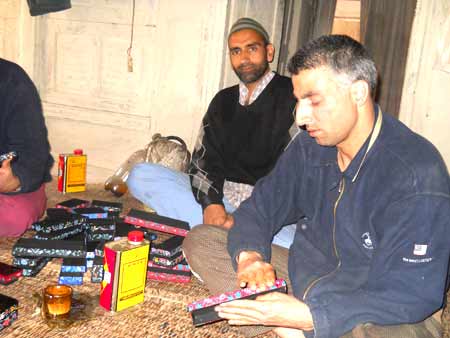 Once an envious craft, papier mâché is now a cause of penury for its craftsman. Shazia Yousuf visits Kamangarpora, the locality in Srinagar known to be the hub of the craft, and finds unhappy lives mired in the trade.
Once an envious craft, papier mâché is now a cause of penury for its craftsman. Shazia Yousuf visits Kamangarpora, the locality in Srinagar known to be the hub of the craft, and finds unhappy lives mired in the trade.
In a three room dilapidated house, 70 year old Hajira lives with her two unmarried sons Shabir Hussain Khan, 41, and Muntazim Ali Khan, 38, both – papier mâché artisans. Though colours are scattered all over the place, life here smells grey.
“Poverty came, with poverty came disease,” says Hajira.
Since the death of her husband Ghulam Mustafa Khan, a peon in a government school, the family is struggling to make ends meet on papier mâché, the once envious craft. Their monthly income rarely exceeds Rs 2500.
Like them, dozens of other families in Kamangarpora locality in the backyard of Jamia Masjid are paying the price of living on an internationally acclaimed craft, which, however, does not pay much.
Kamangarpora is the hub of papier mâché in Kashmir. Just three decades back, papier mâché was the prime occupation in this mohalla and almost all the people would do it for a living.
Resdients say the area got its name, Kaman (bow) Gar (Designer) as Dogra monarch Hari Singh would visit this place for ornamentation of his bows, arrows and swords. Today, however, only some of the households are associated with the craft.
“It is only poor families like us who do it now,” says Shabir.
Shabir and his brother picked up the craft in their childhood, as seven year olds.
“Our father wanted us to learn the most flourishing craft of those days,” he explains. The trade declined, pushing its artisans into penury and depression.
Muntazim suffers from psychiatric problems. The medicines cost him 30 rupees every day. Though he manages to earn that sum, his mother Hajira has to keep vigil on him for whole day, as doctors have diagnosed suicidal tendencies in him. “He can end his life anytime,” Hajira says.
Hajira’s youngest son Mohammad Iqbal Khan, 25, left home for Delhi, where he works as a salesman.
The papier mâché artisans sell their wares to wholesalers who make payments after prolonged intervals.
“The money then goes in paying the debts, we cannot demand payment on monthly basis, they say either wait or sell your products somewhere else,” says Shabir.
Penury hasn’t allowed an escape either. “I am 40, illiterate, and too poor to start my own venture. If I think of learning some other craft, what will we eat until then.”
Muntazim is under heavy debts, accrued from paying for his treatment. “I am recuperating from acute pancreatic infection, I spent three months in hospital and 60,000 rupees went in treatment that I borrowed from many people,” he says.
Muntazim had registered for union government sponsored Rajiv Gandhi health insurance scheme for artisans, but it did not help him.
Shabir’s neighbour Ali Mohammad Dar lives in an adjacent house with his wife and three children. A dark staircase leads to a small room of plywood sheet walls in the balcony of his father’s house. Two curtains divide the area into bedroom, kitchen and bathroom.
Dar and his 18 year old daughter are working on papier mâché bangles. It takes three hours to finish a bangle and fetches four rupees. Fifteen days of rigorous work would fetch Dar Rs 500. “I have to buy her a uniform, it’s urgent,” Dar says.
Tabasum, a first year BA student has already missed a week at her college. She might need to skip couple of weeks more. “This is nothing, last year we cooked Dal (pulses) on Eid-ul-fitr, none of my children complained despite being on fast for whole month of Ramadhan,” Dar says.
Raw material prices have increased manifold in the last two decades, but Dar says wages have hardly seen a rise. “A colour bottle that I would buy for four rupees now costs Rs 22 but wages are the same. They still pay four rupees for a bangle that I used to get in my childhood,” sighs Dar adding that he would have killed himself had he not been put on antidepressants on time by his doctor.

Ill conceived government policies, projected to help people, fail on ground.
Fida Hussain Joo, a 33 year old undergraduate has been engaged in papier mâché along with his brother for a decade. He says he tried to utilise government schemes, but found nothing that could benefit an artisan. “I tried to go for self-employment scheme to start my own unit, but all I got was disappointment,” says Joo.
The monthly instalment for a self employment scheme that would provide a loan of Rs 1,60,000 to artisans for establishing their own units would come around at Rs 3300. “Tell me how can an artisan like me who barely earns Rs 3,000 per month pay an instalment Rs.3300. And the guarantor should be government employee, where from should we get them and if I find any, why would he help me and create unnecessary trouble for himself,” asks Joo.
He says the schemes are not designed to help artisans and involve hassling documentation.
Syed Sarwar Hussain, 37, another artisan, lives in the house constructed by his grandfather, 80 years back. “I thank him for whatever he has kept for me. I can’t think of constructing a new house. My God knows how I manage school fees of my children,” Sarwar says.
Sarwar lives with his mother, wife, three children and two younger brothers who are also artisans. “Thirteen hours of work fetches us 50 to 60 rupees at the end of the day,” says Sarwar.
His brother Tajamul, 29, an undergraduate says he cannot think of his marriage in these financial conditions. “We hardly manage the school fee of our nephews, I can never think of marriage, so many times we had no food to eat, no decent house to live in, why should we spoil someone’s life,” he says.
It is the compulsion not passion that makes the craft survive in Kamagarpora. Only the poor and ill stick to it.
Mirza Ghulam Mohammad Hussain, 57, says he would have switched over to something else had an accident not disabled his right foot. Hussain is however happy that his son worked hard to become a doctor.
“I never encouraged him for this work. There was a time when 40 girls would work in my workshop, today if someone asks for my opinion (on whether to learn the craft) I never recommend.”
Like Hussain, Aashiq Hussain Joo kept his sons away from the craft. His two sons are working outside state, one a salesman another electrician.
Ashiq recalls how as a child he would see his father take out his turban and placing his artefact on it. “He would tell me to touch the paint only after prayers and ablution. But I can’t preach my sons the same. I want them to live a comfortable life even if they live away from me,” he says.
Aashiq says, the outbreak of armed militancy in 1990’s dealt a huge blow to the craft as the main clientele, tourists, kept away.
“Whatever little is left benefits either wholesalers or exporters, and not artisan like me. People who represent us take awards for our artefacts but whenever we go with a piece they raise their brows and let the payments, due to us, linger,” he says
Once known for its artistic zeal, Kamangarpora is stung by poverty now.













